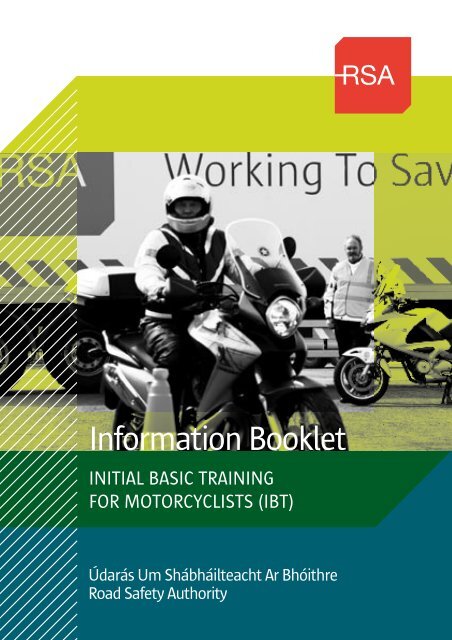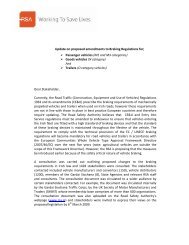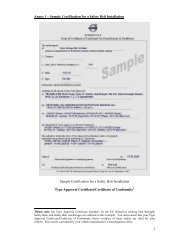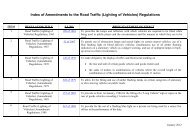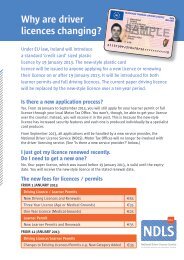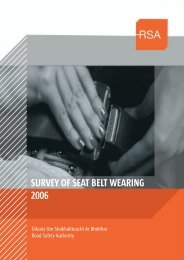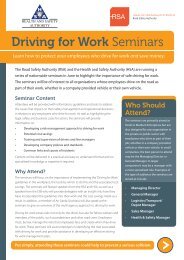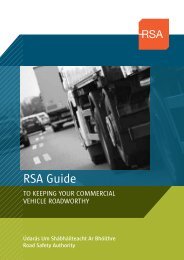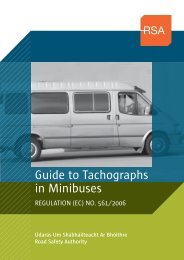IBT Information Booklet (935kB) - Road Safety Authority
IBT Information Booklet (935kB) - Road Safety Authority
IBT Information Booklet (935kB) - Road Safety Authority
Create successful ePaper yourself
Turn your PDF publications into a flip-book with our unique Google optimized e-Paper software.
<strong>Information</strong> <strong>Booklet</strong><br />
INITIAL BASIC TRAINING<br />
FOR MOTORCYCLISTS (<strong>IBT</strong>)<br />
Údarás Um Shábháilteacht Ar Bhóithre<br />
<strong>Road</strong> <strong>Safety</strong> <strong>Authority</strong>
Contents<br />
What is motorcycle <strong>IBT</strong>? 2<br />
Where can I go for motorcycle <strong>IBT</strong> training? 3<br />
About motorcycle <strong>IBT</strong> trainers 3<br />
The motorcycle <strong>IBT</strong> training course 3<br />
Choosing your bike and equipment 4<br />
Getting the most from your training 5<br />
Your log book 5<br />
Certificate of completion 6<br />
After your training 7<br />
The <strong>IBT</strong> motorcycle training modules 8<br />
If you are concerned about your training or trainer 10<br />
The direct access chart 12<br />
The progressive access chart 14<br />
Examples of progression 16<br />
1
What is motorcycle <strong>IBT</strong>?<br />
<strong>IBT</strong> stands for Initial Basic Training – a training course for learner drivers. It can<br />
help you to master basic motorcycling skills and improve your knowledge of<br />
road safety. The standard course lasts 16 hours and is broken into four modules,<br />
which you can take at different stages. In addition, there is a Progression Module<br />
to allow riders to change vehicle types and sizes. See page 7 for more detail on<br />
what’s covered in the training.<br />
We know from statistics that motorcyclists are vulnerable on our roads and face<br />
risky situations. It is important that you have the information and skills you need<br />
to deal with the various hazards you will face on your bike. <strong>IBT</strong> is your ‘first step’<br />
on the road to becoming a safe and competent rider.<br />
You will have to complete a motorcycle <strong>IBT</strong> training course before you can take<br />
your bike on the road unsupervised. At the end of the <strong>IBT</strong> course you will get a<br />
Certificate of Completion. You should keep this with your learner permit.<br />
You can take Initial Basic Training courses on vehicles in these licence<br />
categories:<br />
Type of<br />
<strong>IBT</strong> Training<br />
Course<br />
Learner Permit<br />
Needed<br />
Description<br />
Engine Size<br />
Small<br />
Motorcycles<br />
AM<br />
Moped (Tricycles with a<br />
design speed not exceeding<br />
45km/h Iight quadricycle;<br />
whose unladen mass is not<br />
more than 400kg and whose<br />
maximum net engine power<br />
does not exceed 15 kW)<br />
< 50cc<br />
Small<br />
Motorcycles<br />
A1<br />
Motorcycle (Tricycles<br />
less than 15kW and light<br />
quadricycle<br />
< 125cc<br />
Large<br />
Motorcycle<br />
A2<br />
35Kw Restricted (Tricycles<br />
less than 15 kW and light<br />
quadricycle)<br />
< 35 Kw of<br />
power<br />
2
Motorcycles A Motorcycle (All tricycles and<br />
light quadricycles)<br />
Un restricted<br />
Motor<br />
Vehicles<br />
B<br />
(Code 73)<br />
Quadricycle (For those<br />
with certain learner permit<br />
restrictions)<br />
Where can I go for motorcycle <strong>IBT</strong> training?<br />
The <strong>Road</strong> <strong>Safety</strong> <strong>Authority</strong> (RSA) has approved motorcycle <strong>IBT</strong> trainers<br />
throughout the country. You can only take the <strong>IBT</strong> course with an approved<br />
trainer. Some approved driving instructors (ADI) provide normal learner driver<br />
training but not <strong>IBT</strong>. To make sure your training is with a person who is <strong>IBT</strong><br />
approved, check the list on our website www.rsa.ie – follow the ADI link for a list<br />
of <strong>IBT</strong> trainers in your area. You may also ask your local motorcycle dealer to<br />
advise you on finding an <strong>IBT</strong> trainer.<br />
About motorcycle <strong>IBT</strong> trainers<br />
All approved <strong>IBT</strong> trainers are motorcycling instructors and they have the training<br />
resources they need to deliver <strong>IBT</strong>. You can learn with confidence in a safe<br />
environment and the trainer will only let you progress to the next module of the<br />
course when they are sure you have the requisite knowledge and or skills<br />
required in the previous module. We monitor the work of each <strong>IBT</strong> trainer<br />
through the Approved Driving Instruction (ADI) Unit of the RSA.<br />
The motorcycle <strong>IBT</strong> training course<br />
We have worked with motorcycle driving instructors to put together the <strong>IBT</strong><br />
course. We have also run trials of the course. We have designed the modules to<br />
allow you to move between <strong>IBT</strong> trainers if you need to, for example if you move<br />
out of the area.<br />
The Standard <strong>IBT</strong> course covers four separate modules (numberred 1-4), there<br />
is also a progression Module (Module 5), each of which mixes theory and<br />
practice. To make it more varied and interesting, some parts of the modules<br />
are delivered in a classroom, some on a training site or yard and some out on a<br />
public road under the supervision of your trainer. See page 7 for more details of<br />
the modules.<br />
3
If you have already completed <strong>IBT</strong> on an automatic type motorcycle and now<br />
wish to ride a manual type, you must undergo a progression module which<br />
covers module 2 and 4 of the syllabus on the new type of motorcycle, there is<br />
no need to repeat module 1 and module 3 again. When moving from a category<br />
‘A1’ full driving licence, to a category ‘A2’ type learner permit, in either manual<br />
or automatic” then a progression module needs to be completed on the larger<br />
motorcycle. Each category of Learner permit also has minimum ages and unless<br />
you are over 24 yrs of age there is a requirement to have held an A2 type driving<br />
licence for two years before you can move on to a full unrestricted A licence.<br />
See Appendix A for details of direct and progressive access to the various licence<br />
categories.<br />
A person who is 24 years or older and is the holder of a Category “A” licence<br />
(Restricted to 25 kW) and wishes to have the 25 kW restriction removed, Your<br />
ADI must obtain a unique confirmation code from the Driver Education Section,<br />
prior to the commencement of any training for this purpose. This will ensure<br />
you do not undergo unnecessary or incorrect training.<br />
If the holder of a Category ‘B’ + code 73 type (Tricycle) now wishes to ride a<br />
Category ‘AM’, ‘A1’, A2 or ‘A’ in either manual or automatic then the holder<br />
must also complete the progression module on the new vehicle type.<br />
For safety reasons, there are limits to the number of learners a trainer can work<br />
with at any one time:<br />
In the classroom, there is a maximum of 12 learners to one trainer.<br />
On the site, there is a maximum of two learners to one trainer.<br />
On the road, there is a maximum of two learners to one trainer.<br />
Choosing your bike and equipment<br />
Your bike and other equipment should be ‘fit for purpose’. Look for the<br />
appropriate quality mark before you buy. Discuss your needs with a motorcycle<br />
dealer so that you get the gear that suits your needs. Personal protective<br />
equipment (PPE) means appropriate clothing and a secure helmet. Choose gear<br />
that is bright in colour, practical to wear and the correct size for you. A loose or<br />
un-fastened helmet can be extremely dangerous. Buy only from a trusted dealer<br />
and never buy or wear a second-hand helmet. For some useful advice on PPE for<br />
motorcyclists, see page 149 of the Rules of the <strong>Road</strong>.<br />
There are rules about what type of motorcycle is acceptable to undergo training<br />
and or your Practical driving test. Consult your <strong>IBT</strong> trainer or visit www.rsa.ie for<br />
further details.<br />
4
Getting the most from your training<br />
When you contact a <strong>IBT</strong> trainer, ask their advice on how best to prepare for<br />
the course. You should also familiarise yourself with the following booklets:<br />
The Rules of The <strong>Road</strong><br />
‘Learning to Ride a Motorcycle’<br />
Essential Skills – the official motorcycling manual.<br />
You can get ‘This is Your Bike’ from the RSA or your <strong>IBT</strong> trainer. You can buy the<br />
other two booklets from most good book shops.<br />
You can get ‘Learning to Ride a Motorcycle’ from www.theorytest.ie or your <strong>IBT</strong><br />
trainer. You can buy the other two booklets from most good book shops. Before<br />
you attend your first training session, make sure you have everything you need.<br />
Your trainer will check your learner permit, insurance (if you need it for the onroad<br />
module) and the condition of your own PPE. If they are not satisfied about<br />
any of these, you may not be able to go ahead with your training as planned.<br />
Apart from wasting your own time, you may have to pay for the missed session.<br />
The trainer will normally begin the course by registering learners and<br />
checking their permits. They will then set out the aims of the training and any<br />
‘housekeeping’ rules about things such as asking questions and break times.<br />
Your trainer will want to be satisfied that your motorcycle and protective<br />
gear are both roadworthy and serviceable and that you yourself are fit to ride.<br />
You will be asked to complete a declaration on each training day. If you are<br />
progressing along the licence categories please check to make sure you are<br />
entitled to progress in accordance with the new rules on progression visit<br />
www.rsa.ie for further details.<br />
Pay attention to your trainer and the other learners. Take part in discussions –<br />
everyone has something to offer; you will help others to benefit from your<br />
experience as well as learn from theirs. You should find the course challenging<br />
as well as enjoyable. During the pilot phase of <strong>IBT</strong>, most learners said that they<br />
enjoyed the training and the contact with other like-minded people who<br />
wanted to learn to ride.<br />
Your log book<br />
At your first session, your trainer will give you a personal log book. As you<br />
complete each module, your trainer will sign off and record this in your log<br />
book. Take care of your log book – keep it safe and bring it along with you to<br />
each training session so that your trainer can update it. If you lose it you will<br />
have to pay a fee to get a replacement from your trainer.<br />
5
<strong>IBT</strong> Log Book JUNE 2010 amend ART 01/12/2010 14:43 Page 1<br />
It is your responsibility to have your log book updated.<br />
If you switch to another trainer, they will only be able<br />
to certify Modules you have completed with them.<br />
Take the time to complete the self analysis sections<br />
of your logbook. By doing this you will help<br />
consolidate your learning and help your trainer<br />
to deal with issues of concern. Self analysis is<br />
regularly used by adult learners to help them<br />
plan and progress through their training. Sharing<br />
your thoughts with your trainer will help them to<br />
prepare more effective lesson plans which could<br />
save you money in the long run<br />
Initial Basic<br />
Training for Motorcyclists<br />
Trainee Log Book<br />
An tÚdarás Um Shábháilteacht Ar Bhóithre<br />
<strong>Road</strong> <strong>Safety</strong> <strong>Authority</strong><br />
Important: You should complete all four modules of the standard course as<br />
soon as practicable. Once you have completed all four modules, your trainer will<br />
give you a Certificate of Completion. You must complete all four modules within<br />
two years of successfully completing Module 1. Failure to do so will result in you<br />
having to repeat the entire course again from the beginning of Module 1. When<br />
availing of progressive access the modules you need to do will vary according to<br />
your previous training and experience so please check carefully to ensure you<br />
are undergoing the correct training modules.<br />
Certificate of<br />
completion<br />
The certificate of<br />
completion looks<br />
like this:<br />
CertifiCate of SatiSfaCtory Completion<br />
of initial BaSiC training (motorCyCleS)<br />
TEASTAS COMHLÍONTA SHÁSÚIL UM<br />
THÚSOILIÚINT BHUNATA<br />
<strong>Road</strong> Traffic (Courses of Instruction) (Motorcycles) Regulations<br />
Rialúcháin maidir le Trácht ar Bhóithre (Cúrsaí Theagaisc) (Gluaisrothaithe)<br />
M Holder of Learner Permit Number: /<br />
An tUasal<br />
Sealbhóir na hUimhreach do Cheadúnas Foghlaimeora<br />
has successfully completed Initial Basic Training in respect of<br />
D’fhreastal an té thuasluaite ar Thúsoiliúint Bhunata a bhaineann le<br />
TRaININ CRS CaTR<br />
CATAGR CRSA OA<br />
aM or ó a1 a a<br />
ehicle Registration<br />
Clárú feithicle<br />
Tricycle<br />
Rothar Trianach<br />
ehicle type<br />
Cinéal feithicil<br />
Light uadricycle (aM)<br />
Cuadrothar adrom<br />
uadricycle Cuadrothar<br />
B Code Cód <br />
Transmission<br />
Trasseoladh<br />
Manual<br />
automatic<br />
Uathoibríoch áimhe Uathoibríoch<br />
Direct access<br />
Rochtain Dhíreach<br />
Progressive access<br />
Rochtain leanúnach<br />
a1 a<br />
a a<br />
ngine CC<br />
cc an innill<br />
/ output<br />
Putaschur<br />
Signed (Trainer)<br />
Sínithe (Oiliúnóir)<br />
Print Name<br />
Priontáil Ainm<br />
Note: The holder of an appropriate learner permit and this certificate may<br />
ride a motorcycle vehicle in the category indicated without having to be<br />
accompanied by a registered Instructor for that category. This certificate<br />
is valid for two years from the date of issue and cannot be extended.<br />
Date of Issue<br />
Dáta Eisithe<br />
Trainer Number<br />
Uimhir Oiliúnóra<br />
Holder’s Signature<br />
Síniú an Sealbhóra<br />
<strong>IBT</strong> STaMP<br />
Stampa an ttF<br />
Tá cead ag sealbhóir ceadúnais foghlaimeora cuí a bhfuil seilbh aige ar an<br />
deimhniú seo feithicil gluaisrothair sa chatagóir a thaispeántar a mharcaíocht,<br />
agus ní gá dó Teagascóir cláraithe don chatagóir sin a bheith ina theannta.<br />
Tá an Teastas seo bailí ar feadh dhá bhliain ón dáta eisiúna agus ní féidir<br />
é a shíneadh.<br />
Size: cert size 199.5mm x 150mm<br />
You should keep your certificate with your learner permit for the bike you are<br />
riding, whenever you are on a public road or in a public place. You may be<br />
required to produce your learner permit or your <strong>IBT</strong> Certificate for inspection<br />
6
if a Garda requests them. You may also be asked to produce your certificate to<br />
your driver tester on the day of your practical riding test. If you have availed of<br />
the progression route you will need to submit your certificate to the licensing<br />
authorites to obtain your new higher category driving licence Please be aware<br />
it is not permissible to avail of the progression route twice in succession, that<br />
means once availed of you must undergo apractical driving test for the next<br />
category of licence.<br />
Your <strong>IBT</strong> certificate will continue to be valid unless your learner permit lapses for<br />
a consecutive period of five years or more.<br />
After your training<br />
When you have successfully completed the course you will be able to ride on a<br />
public road without being supervised by an <strong>IBT</strong> trainer. This does not mean that<br />
you are finished learning – it just allows you to continue learning. Safe practice<br />
of what you have learnt during motorcycle <strong>IBT</strong> will help you to develop your<br />
skills. You should practise these every time you ride your bike.<br />
If you have applied for a practical driving test<br />
To prepare for your driving test, stay in a learning frame of mind as you practise<br />
for it. Your driving test may require you to do some aspects of practical riding<br />
that are not part of the standard motorcycle <strong>IBT</strong> course, such as overtaking and<br />
the avoidance manoeuvre. You can do further training with your <strong>IBT</strong> trainer<br />
or any other motorcycle approved driving instructor (ADI). You should aim to<br />
complete your motorcycle training and pass your driving test whilst your <strong>IBT</strong><br />
certificate is still valid.<br />
Get as much practice as you can on different road types and conditions, but<br />
not on motorways unless you hold a full driving licence for the category of<br />
Motorcycle being used. Involve your trainer and/or other riders who can help<br />
you learn. A mix of formal and informal training is a good way to develop your<br />
riding skills and risk awareness. Discuss the risks and how to reduce them with<br />
friends and other riders to help you learn more quickly and effectively. Finally,<br />
remember that motorcycle riding can be fun and your <strong>IBT</strong> training will help you<br />
to have many years of safe and enjoyable use of your motorbike.<br />
7
The <strong>IBT</strong> motorcycle training modules<br />
Module 1 has six objectives. You will need at least three hours to achieve them<br />
They cover:<br />
1. Personal protective equipment (PPE)<br />
2. Introduction to motorcycle controls<br />
3. Technical checks<br />
4. Placing motorcycle on and off the stands<br />
5. Walking alongside the motorcycle<br />
6. How to start and stop the engine Including precautions for mounting<br />
and dismounting<br />
Module 2 has 10 objectives. You will need at least five hours to achieve them<br />
They cover:<br />
1. Moving off and stopping (includes on site riding)<br />
2. Use of brakes<br />
3. Use of gears<br />
4. Slow riding<br />
5. Figure of eight exercise<br />
6. U-turn exercise<br />
7. Slalom exercise<br />
8. Rear observations and mirrorwork<br />
9. Turning left and right<br />
10. Emergency adjustment of speed - Emergency Stop<br />
Module 3 has 10 objectives. You will need at least two hours to achieve them<br />
They cover:<br />
1. Legal requirements<br />
2. Rules of the road<br />
3. Being seen<br />
4. <strong>Road</strong> surfaces<br />
5. <strong>Road</strong> and lane position<br />
6. Rear observations and mirrors<br />
7. Speed<br />
8. Anticipation and reaction including dealing with Emergency service<br />
vehicles.<br />
9. Weather conditions (including Modal choices and Route Planning)<br />
10. Fatigue<br />
8
Module 4 has eight objectives. You will need at least six hours to achieve them.<br />
They cover:<br />
1. Gradients<br />
2. Junctions<br />
3. Traffic lights<br />
4. Roundabouts<br />
5. Safe distance<br />
6. Anticipation and reaction to hazards including dealing with emergency<br />
service vehicles<br />
7. Pedestrian & rail crossings (rail where possible)<br />
8. Bends<br />
During this module your trainer will be in radio link with you from his/her own<br />
motorcycle on a public road. They will supply the radios. Please note: You may<br />
have to supply your own PPE for any or all of the training – please check with<br />
your trainer.<br />
Module 5 (Progression Module)<br />
This module includes topics previously covered during Modules 2 & 4 with<br />
some additional new content to allow ‘progression’ the training needs to<br />
be undertaken on the new vehicle type, you wish to change to, e.g. from<br />
‘automatic’ to ‘manual’. This progression Module will facilitate changes in<br />
your entitlements without you having to undergo the full programme again<br />
and in limited circumstances without you having to undergo a practical<br />
driving test. For Direct access purposes to Category ‘A’ or ‘A2’ motorcycles,<br />
you will need 13 hours to complete this module. Where <strong>IBT</strong> has already<br />
been completed and you are availing of ‘progressive access’ then you will<br />
need 11 hours to complete this module.<br />
1. Moving off and stopping<br />
2. Use of brakes<br />
3. Use of gears<br />
4. Slow riding exercise<br />
5. Figure of eight exercise<br />
6. U-turn exercise<br />
7. Slalom exercise<br />
8. Rear observation and mirror work<br />
9. Turning left and right<br />
10 Obstacle Avoidance<br />
11. Emergency adjustment of speed<br />
Emergency Stop<br />
12. Overtaking<br />
13. Carrying pillion Passengers<br />
14. Using a Sidecar / towing a Trailer<br />
15. Gradients<br />
16. Junctions<br />
17. Traffic lights<br />
18. Roundabouts<br />
19. Safe distance<br />
20. Anticipation and reaction to<br />
hazards including dealing with<br />
Emergency service vehicles.<br />
21.Pedestrian & rail crossings (rail<br />
where possible)<br />
22. Bends<br />
23. Socially responsible Riding/driving<br />
9
During the on road parts of this module your trainer will be in radio link with<br />
you from his/her own motorcycle on a public road. They will supply the radios.<br />
Some objectives will be in a classroom and others in an ‘off road centre’<br />
Please note: You may have to supply your own PPE for any or all of the training –<br />
please check with your trainer<br />
If you are concerned about your training or trainer<br />
If for any reason you are not happy with your training or have concerns about<br />
how you are progressing, please take this up in the first place with your trainer.<br />
They will probably be able to resolve any difficulties with you. If that is not<br />
possible, please contact the Approved Driving Instruction (ADI) Unit of the <strong>Road</strong><br />
<strong>Safety</strong> <strong>Authority</strong> on: (096) 25 000 or email adi@rsa.ie.<br />
Your <strong>IBT</strong> trainer will guide you through the various learning points and other<br />
related motorcycling issues as appropriate.<br />
10
Process of obtaining a motorcycle<br />
Age<br />
16<br />
Age<br />
16<br />
Category<br />
AM<br />
Category<br />
A1<br />
• Theory test (if not<br />
already completed)<br />
• Apply for Learner Permit<br />
• Initial Basic Training<br />
Modules 1-4 (16 hrs)<br />
• Driving Test<br />
(after 6 months)<br />
• Age 16<br />
• Theory test (if not<br />
already completed<br />
• Apply for Learner Permit<br />
• Initial Basic Training<br />
Modules 1-4 (16hrs)<br />
• Driving Test<br />
(after 6 months)<br />
Obtain Cat. AM<br />
full licence<br />
Obtain Cat. A1<br />
full licence<br />
NOTE: The chart above sets out the various ‘Direct Access’ options for each category<br />
of Motorcycle Licence. These examples assume that the holder has not previously held<br />
a motorcycle licence. The chart on the next page sets out the various ‘progressive access’<br />
options for those that may have previously held a motorcycle licence in either A1, or A2.<br />
Visit www.rsa.ie/RSA/Learner-Drivers/New-Driver-Licensing-Rule<br />
12
driving licence through Direct Access<br />
Age<br />
18<br />
Age<br />
24<br />
and over<br />
Category<br />
A2<br />
Category<br />
A<br />
• Age 18<br />
• Theory test (if not<br />
already completed<br />
• Apply for Learner Permit<br />
• Initial Basic Training<br />
Modules 1, 3 and 5<br />
inclusive on A2 bike. If<br />
already completed for<br />
AM or A1 do progression<br />
module 5 <strong>IBT</strong> on A2<br />
machine<br />
• Age 24<br />
• Theory test (if not<br />
already completed<br />
• Apply for Learner Permit<br />
in Category A<br />
• Initial Basic Training<br />
Modules 1, 3 & 5<br />
• Driving Test<br />
(after 6 months)<br />
• Pass driving test<br />
(after 6 months)<br />
Obtain Cat. A2<br />
full licence<br />
Obtain Cat. A<br />
full licence<br />
s-from-January-2013/ for a list of frequently asked questions.<br />
13
Process of obtaining a motorcycle d<br />
In all cases:<br />
• Min Age: 18yrs<br />
Progression<br />
from A1 to A2<br />
• Apply for Learner Permit in Category A2 after holding a full Category A1 driving<br />
licence for a minimum of two years.<br />
• Complete Progression Module (Module 5) on an A2 type motorcycle (11hrs)<br />
• Having completed Module 5 you may then obtain your full Category A2 type<br />
driving licence. Alternatively you may choose to undergo and pass a practical<br />
driving test in Category A2 which leaves you with the options set out below;<br />
Options<br />
1. If you chose to undergo and pass the practical driving test on a Category A2 type<br />
motorcycle (no need to wait 6 months) and later on you choose to progress to a<br />
Category A type motorcycle (having held your Category A2 driving licence for 2<br />
years). You may proceed without the need to undergo a practical driving test on<br />
a Category A type motorcycle.<br />
2. If you had not taken and passed a practical driving test to obtain your Category<br />
A2 driving licence (that is, you obtained it by undergoing a progression module)<br />
you may not progress on without passing a practical driving test for a Category A<br />
type driving licence. In order to progress to a Category A, you must hold your<br />
Category A2 type driving licence for at least two years, undergo the progression<br />
module (module 5) and pass a practical driving test on the Category A type<br />
motorcycle.<br />
Notes<br />
• Where you have previously undergone a practical driving test you will not be<br />
required to wait 6 months before sitting another test between Categories A2 and<br />
Category A.<br />
• If you are aged 24 yrs or over you may opt for the Category A ‘Direct Access’ route<br />
without the need to obtain a Category A2 driving licence and wait the two years.<br />
Visit www.rsa.ie/RSA/Learner-Drivers/New-Driver-Licensing<br />
14
iving licence through Progressive access<br />
Progression<br />
from A2 to A<br />
In all cases:<br />
• Min Age: 20yrs<br />
• Apply for Learner Permit in Category A<br />
• Complete Progression Module (Module 5) on an A type motorcycle (11hrs)<br />
• Must have held Category A2 driving licence for a minimum of 2 years. (or be at<br />
least 24 years of age and opt for Direct Access to Category A)<br />
Options<br />
1. If you obtained your Category A2 driving licence by passing your practical driving<br />
test between Categories A1 and A2 you may then apply for your Category A<br />
driving licence without the need to undergo a further practical driving test.<br />
2. If you obtained your Category A2 driving licence completing the progression<br />
module from A1 to A2 you must then apply for and pass a practical driving test<br />
for your Category A driving licence<br />
Notes<br />
• Where you have previously undergone a practical driving test you will not be<br />
required to wait 6 months before sitting another test between categories A1 and<br />
A2 or A2 and A.<br />
• If you are aged 24 yrs or over you may opt for the Category A Direct Access route,<br />
without the need to obtain a Category A2 driving licence and wait the required<br />
two years.<br />
The above notes set out options for progression for those who have previously held the relevant category<br />
of full driving licence for the required length of time. If your situation is not set out above please contact<br />
your local <strong>IBT</strong> trainer or the <strong>Road</strong> <strong>Safety</strong> <strong>Authority</strong> (Tel:096 25000) for further information.<br />
NOTE:<br />
If you already hold a full Category A driving licence restricted to 25Kw and wish to remove the restriction<br />
– it may be possible if you are aged over 24yrs and your <strong>IBT</strong> trainer obtains a unique approval number<br />
before your course commences.<br />
-Rules-from-January-2013/ for a list of frequently asked questions.<br />
15
Examples of progression for those with a<br />
Category A learner Permit or Driving licence<br />
If you held a ‘Category A’ Learner permit prior to 6th<br />
December 2010 and are age 24yrs or over you may<br />
progress to the new unrestricted category A driving<br />
licence as follows :<br />
• If you have not completed any Initial Basic Training<br />
You must undergo <strong>IBT</strong> Modules 1,3,& 5 on a motorcycle with a minimum power<br />
output of 40KW and then successfully complete a practical driving test<br />
• If you have previously completed <strong>IBT</strong> on any type of motorcycle<br />
You must now complete the progression module (Module 5) on a motorcycle<br />
with a minimum power output of 40KW and then successfully complete a<br />
practical driving test<br />
• If you have held a provisional licence prior to 1999 (now a Learner permit) –<br />
without a break in validity exceeding 5 yrs<br />
You may now undergo a practical driving test on a motorcycle with a minimum<br />
power output of 40 KW.<br />
If you are aged at least 24yrs and hold a Category ‘A’ full<br />
Driving Licence issued at anytime within the last two<br />
years and wish to remove the power restriction you may<br />
progress as follows:<br />
• You may choose to wait and complete the period of restriction, or<br />
• If you have or have not completed any Initial Basic Training<br />
You must undergo <strong>IBT</strong> Modules 1, 3 & 5 on a motorcycle with a minimum<br />
power output of 40KW<br />
• If you have previously completed <strong>IBT</strong> on any type of motorcycle<br />
You must now complete the progression module (Module 5) on a motorcycle<br />
with a minimum power output of 40KW.<br />
NOTE<br />
In either case the following applies;<br />
1. The Motorcycle must have an un laden mass of at least 180Kg<br />
2. Where an internal combustion engine is used, the engine must be at least 595cc.<br />
3. Where the motorcycle is powered by an electric motor the minimum power<br />
output is 0.25 kw/kg<br />
Please note that from November 2013 the motorcycle used for either <strong>IBT</strong> training or<br />
driving test purposes in Category A, must have a minimum power output of 50 KW.<br />
The minimum power output for a Category A2 type vehicle used for training or the<br />
practical driving test is being reduced to 20kW.<br />
16
NOTES:<br />
17
Designed by One House Communications October 2012<br />
Working to Save Lives<br />
Údarás Um Shábháilteacht Ar Bhóithre<br />
<strong>Road</strong> <strong>Safety</strong> <strong>Authority</strong><br />
Aonad ADI, Páirc Ghnó Ghleann na Muaidghe, Cnoc an tSabhaircín,<br />
Bóthar BÁC, Béal an Átha, Co. Mhaigh Eo.<br />
ADI Unit, Moy Valley Business Park, Primrose Hill, Dublin <strong>Road</strong>,<br />
Ballina, Co. Mayo.<br />
Locall: 1890 50 60 80 tel: (096) 25000 facs: (096) 25252<br />
E-mail: adi@rsa.ie website: www.rsa.ie Ref. <strong>IBT</strong> Info January 2013


